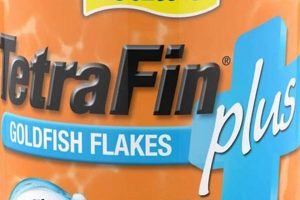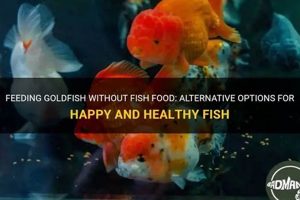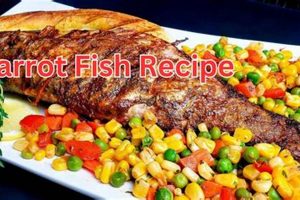This product consists of small crustaceans, Artemia salina, that have been flash-frozen to preserve their nutritional value. These crustaceans, originally hatched in saltwater environments, serve as a dietary component for various aquarium inhabitants, particularly carnivorous and omnivorous fish species. As an example, many tropical fish keepers utilize this product as a supplement to flake food to provide a varied and enriching diet for their aquatic pets.
Its significance lies in offering a source of protein, essential fatty acids, and other nutrients that promote growth, coloration, and overall health in fish. The practice of freezing preserves these elements effectively, minimizing degradation compared to other preservation methods. Historically, aquarists relied on live versions, but the frozen alternative offers convenience and reduces the risk of introducing parasites or diseases into the aquarium ecosystem.
The following sections will explore aspects such as its nutritional profile, appropriate usage guidelines for different fish species, methods for thawing and administering, and considerations for proper storage to maintain its quality and prevent spoilage. Understanding these facets contributes to the responsible and effective utilization of this food source in aquarium management.
Tips Regarding Usage
The following recommendations aim to optimize the nutritional benefits and minimize potential risks associated with employing this product as a fish food source.
Tip 1: Thaw Before Feeding: Submerge the frozen cube in a small container of aquarium water prior to introduction to the tank. This prevents a sudden temperature drop and allows for a more palatable and digestible food source.
Tip 2: Portion Control is Crucial: Observe feeding habits and provide only the amount fish can consume within a few minutes. Overfeeding can lead to water quality degradation and potential health issues.
Tip 3: Rinse After Thawing: After thawing, pour the mixture through a fine mesh net and rinse with aquarium water. This removes excess phosphates and other potentially harmful components released during the freezing/thawing process.
Tip 4: Vary the Diet: While offering nutritional value, it should not be the sole food source. Supplement with high-quality flake food, pellets, or other suitable options to ensure a balanced dietary intake.
Tip 5: Proper Storage is Essential: Keep unused portions sealed tightly in the freezer. Repeated thawing and refreezing diminishes nutritional value and increases the risk of contamination.
Tip 6: Observe Fish Behavior: Monitor fish for signs of digestive issues or allergic reactions after initial introduction. Adjust feeding practices as needed based on observed responses.
Tip 7: Target Feed Specific Species: Some fish species might require smaller pieces or direct feeding. Consider specific feeding methods for bottom dwellers or shy feeders.
Implementing these guidelines will contribute to a healthier and more balanced diet for aquarium inhabitants, promoting optimal health and longevity.
The subsequent sections will address potential issues and best practices for long-term storage to maintain quality.
1. Nutritional Composition
The nutritional composition of frozen brine shrimp significantly influences its value as a food source for aquarium fish. Understanding the components present and their respective roles is crucial for responsible and effective feeding practices.
- Protein Content
Protein constitutes a significant portion of the dry weight of frozen brine shrimp. This macronutrient is essential for tissue growth, repair, and enzyme production within the fish. Adequate protein intake supports healthy development, particularly in juvenile fish, and contributes to the maintenance of muscle mass in adult specimens. The protein content varies depending on the origin and processing methods used, but generally remains a valuable dietary component.
- Lipid Profile
Frozen brine shrimp contains a notable quantity of lipids, including essential fatty acids like omega-3 and omega-6. These fatty acids play critical roles in cell membrane structure, hormone production, and overall immune function. The specific lipid profile can impact fish coloration, reproductive health, and resistance to disease. A balanced lipid content contributes to the overall vitality of aquarium inhabitants.
- Vitamin and Mineral Content
While not typically fortified, frozen brine shrimp naturally contains trace amounts of various vitamins and minerals. These micronutrients contribute to a range of physiological processes, including bone development, nerve function, and antioxidant defense. While the levels may not be sufficient to meet all nutritional requirements, they provide a supplementary source of essential elements for fish health.
- Fiber Content
Fiber aids in digestion and prevents constipation in fish. The chitinous exoskeleton of brine shrimp provides a source of fiber. Proper processing methods ensure the fiber remains digestible and beneficial to fish health.
The interaction between these nutritional components directly determines the suitability of frozen brine shrimp as a food source. While a valuable supplement, it is crucial to recognize that a varied diet, including high-quality flake or pellet food, is essential to meet the comprehensive nutritional needs of aquarium fish.
2. Appropriate Species
The efficacy of frozen brine shrimp as a nutritional supplement for aquarium fish is directly contingent upon species-specific dietary requirements. The indiscriminate application of this food source across diverse fish populations can yield suboptimal results, stemming from mismatches between nutrient profiles and physiological needs. Carnivorous species, for example, derive substantial benefit from the high protein content, facilitating muscle development and overall growth. Conversely, herbivorous fish possess digestive systems ill-equipped to process the chitinous exoskeleton, potentially leading to digestive complications and reduced nutrient absorption. Smaller fish species benefit from this food as it is small in size and easier to ingest. Careful consideration of the species-specific digestive capabilities and dietary needs is paramount to maximizing the nutritional benefits.
Further delineation exists within broad dietary classifications. For instance, certain tropical fish, such as Bettas, readily accept frozen brine shrimp as a supplement to their primary diet of flakes or pellets, exhibiting enhanced coloration and increased activity levels as a result. However, other species, such as larger cichlids, might require a more substantial food source to meet their energy demands. Similarly, some fish might demonstrate allergic reactions or digestive sensitivities to the shrimp, necessitating alternative dietary options. It becomes imperative for aquarists to meticulously research the specific dietary needs of their fish populations prior to incorporating frozen brine shrimp into their feeding regimen. This proactive approach can mitigate potential adverse effects and ensure optimal health outcomes. It is important to ensure the frozen brine shrimp is appropriately sized for the targeted species to prevent choking or feeding difficulties.
In summary, the successful integration of frozen brine shrimp into a fish’s diet hinges on a comprehensive understanding of the target species’ dietary requirements and digestive capabilities. Erroneous assumptions regarding species-specific needs can result in nutritional imbalances and adverse health consequences. By carefully evaluating these parameters and tailoring the feeding strategy accordingly, aquarists can leverage the nutritional benefits of frozen brine shrimp while minimizing potential risks. It’s also important to consider the ecological niche of the fish in their natural environment to replicate their natural diets as closely as possible.
3. Thawing Procedure
The thawing procedure represents a critical step in the preparation of frozen brine shrimp for fish consumption. Improper thawing practices can negate the nutritional benefits and introduce potential health risks to the aquatic environment. Therefore, a standardized approach to thawing is essential for optimizing the utility of this food source.
- Nutrient Retention
Rapid thawing or exposure to elevated temperatures can lead to nutrient leaching from the shrimp. This process reduces the concentration of essential amino acids, vitamins, and fatty acids, diminishing the nutritional value of the food. Controlled thawing, typically at refrigerated temperatures, minimizes nutrient loss, ensuring a more nutritious meal for the fish. The slow process helps preserve the integrity of the shrimp’s cellular structure, preventing the release of valuable nutrients into the surrounding water. Failing to follow this procedure results in a less nutritious food source.
- Bacterial Contamination
Improper thawing practices can facilitate the proliferation of harmful bacteria. Prolonged exposure to room temperature provides an ideal environment for bacterial growth, increasing the risk of introducing pathogens into the aquarium. Thawing brine shrimp in a refrigerator or under cool, running water minimizes the duration of exposure to the “danger zone” of bacterial growth, thus reducing the risk of contamination. If contamination occurs, it can lead to various diseases and illnesses.
- Water Quality Degradation
Thawing brine shrimp in aquarium water directly can introduce organic pollutants, such as phosphates, into the tank. These pollutants can contribute to algal blooms and other water quality problems. A recommended practice involves thawing the shrimp in a separate container with dechlorinated water, followed by rinsing with a fine-mesh net before introducing the food into the aquarium. This reduces the risk of introducing unwanted substances, preserving the water quality.
- Digestibility Enhancement
Thawing frozen brine shrimp softens the exoskeleton, making it more digestible for certain fish species. This is particularly beneficial for fish with delicate digestive systems or smaller mouths. The thawing process allows enzymes in the fish’s digestive tract to more easily break down the chitinous exoskeleton, increasing nutrient absorption. This ensures efficient digestion and reduces the risk of digestive upset.
In conclusion, the thawing procedure plays a pivotal role in determining the nutritional value and safety of frozen brine shrimp as a food source for aquarium fish. Proper thawing techniques, emphasizing controlled temperatures, bacterial control, and water quality considerations, are paramount for optimizing the benefits and minimizing the risks associated with its utilization. In comparing and contrasting these thawing facets, one can conclude the importance of applying the process carefully to avoid harm to the ecosystem in the aquarium.
4. Portion Management
Portion management constitutes a critical element in the responsible administration of frozen brine shrimp to aquarium fish. The quantity of food introduced into the aquatic environment directly impacts water quality, fish health, and overall ecosystem stability. Inadequate portion control can precipitate a cascade of negative consequences, undermining the intended benefits of this dietary supplement.
- Prevention of Overfeeding
Overfeeding, a common consequence of poor portion management, leads to the accumulation of uneaten food at the bottom of the aquarium. This excess organic matter decomposes, releasing ammonia, nitrites, and nitrates into the water column. Elevated levels of these compounds are toxic to fish, causing stress, suppressed immune function, and, in extreme cases, mortality. Consistent adherence to appropriate portion sizes minimizes the risk of overfeeding, thereby mitigating the potential for water quality degradation.
- Reduction of Waste Production
The amount of food consumed directly influences the volume of waste produced by fish. Overfeeding results in increased fecal production, further contributing to the organic load within the aquarium. Efficient portion management ensures that fish consume only the necessary amount of food to meet their nutritional needs, reducing the generation of waste and promoting cleaner water conditions. Reduced waste translates to decreased maintenance requirements and a healthier environment for aquatic inhabitants.
- Minimization of Algal Blooms
Excess nutrients, such as phosphates, introduced into the aquarium through overfeeding, can stimulate the rapid growth of algae. Uncontrolled algal blooms can deplete oxygen levels, obstruct light penetration, and negatively impact the aesthetic appeal of the aquarium. Precise portion control minimizes the introduction of excess nutrients, thereby suppressing algal growth and maintaining a balanced ecosystem. A clean tank will also prevent the fish from getting sick.
- Optimizing Nutritional Intake
Appropriate portion sizes, coupled with a balanced diet, ensure that fish receive the optimal amount of nutrients for their health and well-being. Overfeeding can lead to obesity and other health problems, while underfeeding can result in malnutrition and stunted growth. Careful portion management, tailored to the specific needs of each fish species, promotes optimal nutritional intake and supports long-term health. A healthy diet also will lead to a better breeding environment.
Effective portion management, therefore, serves as a cornerstone of responsible aquarium keeping. By adhering to appropriate feeding practices, aquarists can mitigate the risks associated with overfeeding, maintain optimal water quality, and promote the long-term health and vitality of their fish populations. It also allows the aquarist to better enjoy their tank as it will be clean and vibrant.
5. Storage Longevity
Storage longevity directly dictates the nutritional value and safety of frozen brine shrimp as a food source for aquarium fish. The duration and conditions under which this product is stored significantly impact its quality and suitability for consumption. Extended or improper storage can lead to degradation of essential nutrients and an increased risk of contamination, thereby diminishing its efficacy and potentially harming the fish.
- Temperature Consistency
Maintaining a consistently low temperature is paramount for preserving the quality of frozen brine shrimp. Fluctuations in temperature, particularly during the thawing and refreezing process, promote ice crystal formation. These ice crystals rupture cell membranes, leading to nutrient leakage and a reduction in the food’s overall nutritional value. Storing frozen brine shrimp at a stable temperature of -18C (0F) or lower minimizes ice crystal formation and preserves nutrient integrity. Consistent temperature prevents degradation and preserves nutritional content.
- Prevention of Freezer Burn
Freezer burn, caused by sublimation of moisture from the surface of the frozen product, can render the brine shrimp dry, tough, and unpalatable. It also accelerates the oxidation of lipids, leading to rancidity and a reduction in the content of essential fatty acids. Airtight packaging, such as resealable freezer bags or vacuum-sealed containers, minimizes exposure to air and prevents freezer burn, extending the product’s shelf life and preserving its palatability. Airtight storage is essential to combat freezer burn.
- Minimizing Thawing and Refreezing Cycles
Repeated thawing and refreezing cycles significantly degrade the quality of frozen brine shrimp. Each cycle promotes nutrient loss, bacterial growth, and enzymatic activity, diminishing its nutritional value and increasing the risk of contamination. It is advisable to thaw only the quantity of brine shrimp that will be consumed within a short period, avoiding the need to refreeze unused portions. Single use and one time thawing is recommended for optimal preservation.
- Expiration Date Awareness
Frozen brine shrimp products typically have an expiration date printed on the packaging. This date represents the manufacturer’s estimate of the product’s shelf life under optimal storage conditions. While the product may still be safe to consume after the expiration date, its nutritional value may be significantly diminished. Adhering to the expiration date and regularly inspecting the product for signs of spoilage, such as discoloration, off-odors, or freezer burn, ensures that the fish receive a high-quality and nutritious food source. Expiration awareness ensures freshness and nutritional content.
In summary, storage longevity is a pivotal factor in determining the suitability of frozen brine shrimp as a dietary component for aquarium fish. Maintaining consistent temperatures, preventing freezer burn, minimizing thawing and refreezing cycles, and adhering to expiration dates are essential practices for preserving its nutritional value and ensuring its safety. By implementing these measures, aquarists can maximize the benefits of this food source and promote the long-term health and well-being of their fish populations. Consistent storage leads to a vibrant and healthy ecosystem within the tank.
Frequently Asked Questions
The following section addresses common queries regarding the use of frozen brine shrimp as a dietary supplement for aquarium fish. It aims to provide clear, concise answers based on current scientific understanding and best practices in aquarium management.
Question 1: Is it necessary to thaw frozen brine shrimp before feeding it to fish?
Yes, thawing is highly recommended. Thawing prevents a sudden temperature shock to the fish, which can stress their systems. It also allows excess phosphates released during freezing to be rinsed away, improving water quality.
Question 2: How often should frozen brine shrimp be offered to aquarium fish?
Frequency depends on the species and their dietary needs. For most omnivorous and carnivorous fish, two to three times per week is a suitable supplement to a primary diet of flake or pellet food. Herbivorous fish generally benefit less from this food source.
Question 3: Can frozen brine shrimp transmit diseases to aquarium fish?
The freezing process significantly reduces the risk of disease transmission compared to live brine shrimp. However, proper thawing and rinsing procedures are essential to minimize the potential introduction of any residual pathogens.
Question 4: What is the best method for storing frozen brine shrimp to maintain its quality?
Frozen brine shrimp should be stored at a constant temperature of -18C (0F) or lower. Airtight packaging is crucial to prevent freezer burn. Repeated thawing and refreezing should be avoided.
Question 5: Are there any fish species that should not be fed frozen brine shrimp?
Herbivorous fish, with digestive systems adapted for plant matter, may not derive significant nutritional benefit from frozen brine shrimp. Additionally, some fish may exhibit allergic reactions or digestive sensitivities. Observation is key when introducing new food items.
Question 6: How can the nutritional value of frozen brine shrimp be enhanced?
Some aquarists enrich frozen brine shrimp with vitamin supplements or other beneficial additives before feeding. This can improve the overall nutritional profile and provide specific benefits to fish health and coloration.
The judicious use of this product, following the guidelines outlined above, contributes to the health and well-being of aquarium inhabitants.
The concluding section will provide a summary of the key aspects regarding the responsible and effective use of this product in aquarium management.
Conclusion
This exploration of frozen brine shrimp fish food highlights its multifaceted role in aquarium management. From nutritional composition and species-appropriate application to thawing procedures, portion management, and storage longevity, each aspect significantly impacts its efficacy as a dietary supplement. Careful consideration of these elements is paramount for maximizing benefits and mitigating potential risks associated with its use.
The sustained health and vitality of aquarium ecosystems hinge on informed practices. Aquarists are encouraged to implement these guidelines diligently, continually seeking enhanced understanding of fish nutrition and responsible aquarium keeping, thereby fostering thriving aquatic environments.







